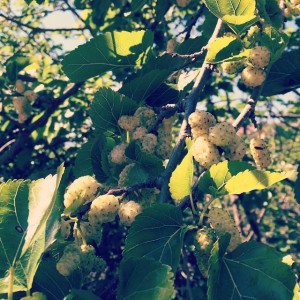 One of our (Litsa & daughter) favorite summer treats is eating fresh mulberries from the village Mulberry trees. There are two trees in our village that are near our family home in Greece. They produce white mulberries that are sweet. In addition to being sweet, mulberries are a great source of health benefiting flavonoid phyto-nutrients.
One of our (Litsa & daughter) favorite summer treats is eating fresh mulberries from the village Mulberry trees. There are two trees in our village that are near our family home in Greece. They produce white mulberries that are sweet. In addition to being sweet, mulberries are a great source of health benefiting flavonoid phyto-nutrients.
Mulberry trees are “large, deciduous trees native to the warm, temperate, and subtropical regions of Asia, Africa, and the Americas. Technically, mulberry fruit is an aggregation of small fruits arranged concentrically around the central axis as in blackberry or loganberries. Each fruit measures 2-5 cm in length.”
The mulberries, we have enjoyed are white but we have also enjoyed a few purple berries this summer too from different Mulberry trees that we’ve walked under as they shaded city streets in the city next to our village in Greece. The purple mulberries were sweet too. However, we much preferred the white mulberries only because they seemed to be sweeter (which in fact may mean that they were just riper)!
Beyond a mere childhood memory that I was thrilled that I could pass on to my daughter, I knew nothing about the mulberry that I loved to eat but embraced more because of its nostalgic connotation. However, after reading more about mulberries nutrition facts, I’m amazed at all of the nature’s health benefits in these little gems.
Try a handful of mulberries if you happen to come in contact with a tree or buy more than a pint full if your local market has these ‘health packed’ fruits for sale this summer.
Try Something New this season!
Fact Credit: Mulberries Nutrition Facts
Latest posts by Litsa @How to Have it All (see all)
- Mushrooms: Portobello, Morels, & More - April 25, 2016
- Giving Back: Get Involved - December 2, 2015
- The Autumn Advantage - December 1, 2015






